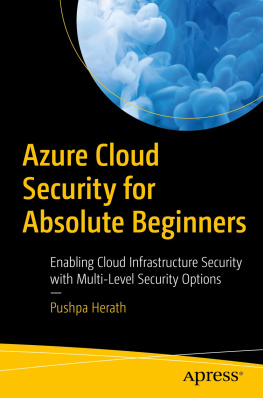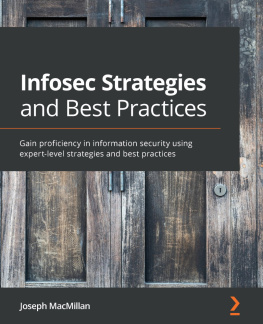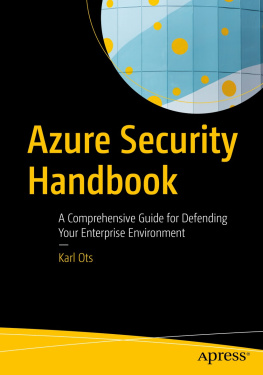AirTight
Security Solutions for the New Millennium
Clint Kirkwood

Copyright 2012 Clint Kirkwood
All rights reserved. No part of this book may be used or reproduced by any means, graphic, electronic, or mechanical, including photocopying, recording, taping or by any information storage retrieval system without the written permission of the publisher except in the case of brief quotations embodied in critical articles and reviews.
WestBow Press books may be ordered through booksellers or by contacting:
WestBow Press
A Division of Thomas Nelson
1663 Liberty Drive
Bloomington, IN 47403
www.westbowpress.com
1-(866) 928-1240
Because of the dynamic nature of the Internet, any web addresses or links contained in this book may have changed since publication and may no longer be valid. The views expressed in this work are solely those of the author and do not necessarily reflect the views of the publisher, and the publisher hereby disclaims any responsibility for them.
Any people depicted in stock imagery provided by Thinkstock are models, and such images are being used for illustrative purposes only.
Certain stock imagery Thinkstock.
ISBN: 978-1-4497-4842-5 (sc)
ISBN: 978-1-4497-5877-6 (ebook)
Library of Congress Control Number: 2012908539
WestBow Press rev. date: 06/21/2012
Contents
To my beautiful wife, Myrah, who inspires me to be forever young. Without your love and patience, life would not be the adventure it is and remains today. You are a treasure, and I will love you until the moon is no more!
Moreover, to my sister and brother-in-law, Sharon and Allen May, who so clearly demonstrate the real meaning of BFFs. Myrah and I will never forget you two.
Clint (June bug)
List of Illustrations
Graphic 1 - Caption-Architectural drawing
Graphic 2 - Caption-Defensible space
Graphic 3 - Caption-Space ownership defined
Graphic 4 - Caption-CPTED
Graphic 5 - Caption-Proper access - one-way in, one-way out
Graphic 6 - Caption-Proper usage of natural surveillance
Graphic 7 - Caption-Proper chain-link fence structure
Graphic 8 - Caption-Chain-link fence structure with gate
Graphic 9 - Caption-Broken window theory
Graphic 10 - Caption-Proper maintenance of greenery
Graphic 11 - Caption- Home displays proper night-lighting techniques
Graphic 12 - Caption- Gateway treatment traffic calming intersection
Graphic 13 - Caption-Centrally located greenery and recreational area
Graphic 14 - Caption-Well defined property
Graphic 15 - Caption-Proper maintenance projects positive image of property
Graphic 16 - Caption-Successful utilization of all CPTED concepts
Graphic 17 - Caption-High traffic areas provide additional eyes & ears
Graphic 18 - Caption-Public housing with front greenery
Graphic 19 - Caption-Neighboring business partnerships
Graphic 20 - Caption-Bank drive-through facing road ATM well visible.
Graphic 21 - Caption-Properly marked and maintained parking facilities
Graphic 22 - Caption-Security cameras in mall parking areas
Graphic 23 - Caption-Bus stop shelters provide safety with maintained.
Graphic 24 - Caption-Planters can serve as natural surveillance and access
Graphic 25 - Caption-Industrial building using CPTED concept
Graphic 26 - Caption-Instructional signs are territorial re-enforcements
Graphic 27 - Caption-Openings allow viewing of parking area
Graphic 28 - Caption-Open and highly visible play area
Graphic 29 - Caption-Park bench with dividers & Signage define uses
Graphic 30 - Caption-Building has hardened security features
Graphic 31 - Caption-Commercial building with hardened security features
Graphic 32 - Caption-Cop-tower - Mini-patrols
Graphic 33 - Caption-Communication stations for emergency notifications
Graphic 34 - Caption-Incandescent Lighting - Fluorescent Lighting
Graphic 35 - Caption-Mercury Vapor Lighting - Metal Halide Lighting
Graphic 36 - Caption-High pressure sodium lighting - Low-pressure sodium lighting
Graphic 38 - Caption-Low-level landscaping design & Fencing as landscaping aesthetics
Graphic 39 - Caption-Access control system with CCTV
Graphic 40 - Caption-Neighborhood watch alert
Graphic 48 - Caption-Executive protection team
Graphic 49 - Caption-Police special response team
List of Tables
Graphic 37 - Table: Locations - Lighting Levels
Graphic 41 - Caption - Table top exercises A
Graphic 42 - Caption - Tabletop exercises B
Graphic 43 - Caption - Tabletop exercises C
Graphic 44 - Caption - Tabletop exercises D
Graphic 45 - Caption - Tabletop exercises E
Graphic 46 - Caption - Tabletop exercises F
Graphic 47 - Caption - Bomb Threat Checklist
After teaching security and criminal justice courses at several high schools, colleges and career schools, I was surprised to learn that the majority of students were not informed regarding the role of security professionals within the security industry. I can recall during numerous class sessions that even though there were many inquiries regarding criminology, parole and policing, there were four particular questions that drew the most concern; 1) how to conduct a security survey; 2) how to identify certain characteristics of those who would likely be involved in workplace violence; 3) what are the proper procedures for responding to emergencies at schools, colleges and universities, and; 4) how to establish an effective executive protection or VIP program.
Therefore, I saw a need to provide a resource that would adequately address the aforementioned questions, as well as provide a method by which to teach the material. This handbook was ultimately developed to address key security concepts, i.e., Crime Prevention Through Environmental Design or CPTED (pronounced sep-ted), Guidelines for Combating Workplace Violence, a Guide for School Safety and Security, and Executive Protection, and finally, provide a useful reference for the law enforcement and security professionals of the future.
As the culture grows increasingly impersonal, individuals are concerned with personal safety and the protection of personal property more than ever before. Likewise, public safety is considered one of the top priorities of the government, though; this trend may be due in part to the terrorist attacks of September 2001. Recent studies revealed that approximately $44 billion dollars per year is spent on public emergency services, including police and fire, and approximately $104 billion dollars is spent in the private sector (the Hallcrest Report II), on similar services. Even as individuals are investing significant resources to protect themselves physically and materially, similarly, businesses are realizing that investing in an effective security program can ultimately protect the bottom line.
Unfortunately, we live with the elements of crime and criminal behavior every day as a fact of life. Early practitioners focused more on the apprehension and punishment of the offender (which often times cannot be initiated until a crime has already been committed), rather than the implementation of crime prevention measures. Crime prevention is a service function and when properly executed, has tremendous impact. In as much as its value may be difficult to measure or quantify, the impact of crime prevention may be determined more appropriately by what does not happen, rather than by what does (Sennewald, 2003). However, experience dictates that large segments of the society think of crime prevention in terms of target hardening (traditional security measures), but there are other advanced practicable options to consider.
Next page







